![[EAI Issue Briefing on Public Opinion No. 91] The Impact of North Korea’s Artillery Strike on Public Opinion in South Korea](../images/bg_tmp.jpg)
[EAI Issue Briefing on Public Opinion No. 91] The Impact of North Korea’s Artillery Strike on Public Opinion in South Korea
Global NK Zoom & Connect | Commentary·Issue Briefing | 2010-12-02
Nae-young Lee · Han-wool Jeong
EAI Issue Briefing on Public Opinion No. 91
[The Peterson Institute for International Economics] North Korea: Witness to Transformation Direct to Quote
1. The Level of Security Concern Peaked at its Highest Number Since 2000
From Engagement to Crisis
On November 23, 2010, North Korea launched a deadly artillery barrage on Yeonpyeong Island; a South Korean island situated 12km off the North Korean coastline. Although ROK Marines returned fire, two Marines and two civilians were killed in the attack by the North. There have been several incidents since the Armistice Agreement that brought an end to the Korean War was signed on July 27, 1953, but this has been the first time a military attack has killed civilians.
The EAI/Han-Kook Research November Public Opinion Barometer, which was conducted after the North Korean attack on Yeonpyeong Island, reveals that 81.5% of respondents feel they are “concerned” about insecurity (34.9% “very concerned”+ 46.6% “slightly concerned”). This is the highest number since the survey first began in 2000.
Figure 1 Percentage of South Koreans’ concerns of insecurity
(including very concerned and slightly concerned) since 2000
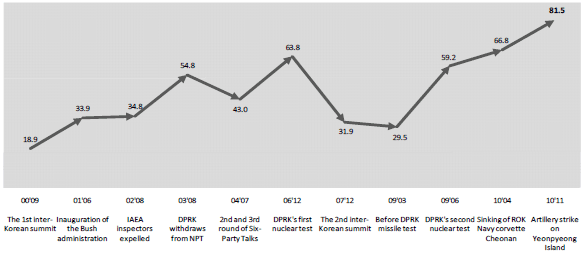
After the inter-Korean summit in 2000, only 18.9% of respondents felt “concerned” about insecurity on the Korean Peninsula. However, this number started to rise as former President George W. Bush took office and the North Korean Nuclear Crisis began. In November 2003, it hit 54.8% following Pyongyang’s withdrawal from the Nonproliferation Treaty. As the Six-Party Talks were initiated to manage the nuclear crisis in 2004, the public’s feelings of insecurity came down to 43.0%. In October 2006, North Korea’s first nuclear test pushed up the number to 63.8%, a year later it drops down to 31.9% with the second inter-Korean summit in October 2007.
Feelings of Insecurity Reach at Their Peak
In the research conducted in March, 2009, only 29.5% of respondents expressed “concern” about insecurity on the Korean Peninsula. But as Pyongyang’s anti-South Korea and anti-United States hard-line policies started to gain momentum so too did the levels of insecurity. The missile launch on April 5, 2009 and the second nuclear test on May 25 in the same year pushed up this “concern” to 32.8% and 48.4% respectively. Furthermore, with increased levels of international sanctions against North Korea such as South Korea’s participation in the Proliferation Security Initiative (PSI), the number goes up higher to 59.2%.
In August 2009, North Korea released the two female reporters who were arrested the previous March and the CEO of Hyundai Group visited Pyongyang, which helped to reduce the levels of insecurity temporarily.
Figure 2 Percentage of South Koreans’ concerns of insecurity (including very concerned and slightly concerned) during the Lee Myung-bak administration 2007-2010
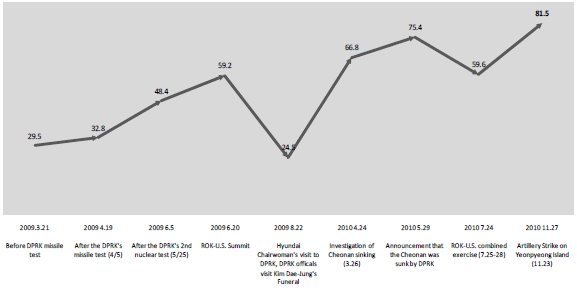
After the Cheonan Incident on March 26, 2010, the “concern” among respondents rose to 66.8%. The number increased to 75.4% when the South Korean administration officially announced that the incident was caused by North Korea. Following the ROK-U.S. combined military exercise and more cooperation between the two states, the level went down to 59.6% until the artillery attack on Yeonpyeong Island pushed the number up to 81.5%, the highest since 2000.
Of the most concern with this incident is that it was the first time North Korea used artillery to directly attack South Korean territory and civilians. Adding to the rising worries, this attack was a violation of the “principle of distinction,” which thus far prohibited raids on civilians and civilian property.
Chances for War on the Korean Peninsula is Considered Slim
The public’s feelings of insecurity on the Korean Peninsula did not mean respondents felt that there was a chance for total war following the attack. For the survey question “Do you think there is going to be a war?” only 26.8% said yes whereas 71.4% said no.
Public opinion did vary depending on gender and age. Only 18.0% of males answered that they think there is going to be a war while 35.4% of females believed so. For the age groups, younger people tended to have more worries about war breaking out: 35.7% of people in their 20s said yes to the same question; 32.5% of those in their 30s, 25.1% of those in their 40s, and 19.6% of those in their 50s or older said yes. Support among respondents for the current administration in South Korea also had an impact on the results. Only 22.2% of respondents who support the administration expressed concerns for total war, while 30.9% of respondents who oppose the current administration are concerned about the outbreak of war. Education, occupation, and region did not yield any noticeable difference.
Figure 3 Assessment of Chances for War by Different Groups (“A war on the Korean Peninsula is likely to break out” (%))
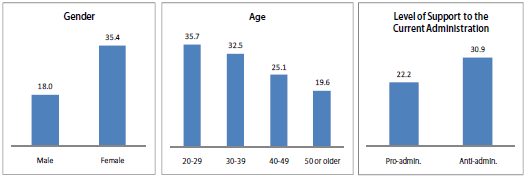
2. Evaluation of Seoul’s Response to the Attack on Yeonpyeong Island
Progressives and Conservatives both Critical
Reflecting the shock and anger of the South Korean people, Figure 4 shows the public’s cold attitude to the government’s response to the attack on Yeonpyeong Island. Whereas 24.7% of respondents answered that the government reacted well (including respondents who answered ‘excellently’ 1.9% and ‘well’ 22.8%), 72% believed that the response was poor (includes ‘poor’ 46.0%, ‘very poor’ 26.0%).
It deserves attention that not only supporters of the opposition Democratic Party (DP) but also the ruling Grand National Party (GNP) showed negative views regarding the reaction of the government. 63.4% of GNP supporters and 72.8% of conservatives said that the government’s reaction was not enough. This reveals that the government does not even receive support from pro-government circles. Even the majority of the respondents (58.8%) who responded that President Lee has conducted state affairs well said that the administration’s reaction to the North Korean attack was inadequate.
Reflecting this public mood, the Blue House is faced with a wide range of criticism from politicians, the media, and civil society. Some have criticized that Seoul should have punished North Korea militarily even at the risk of escalating tensions. Others blame the hard line policy of the Lee administration toward North Korea in provoking the attack. Another group raised criticism on the confusion among different government agencies in the initial countermeasures to the attack and the failure to convey its message to the public. Finally there were those who raised concerns about the aging military facilities and the emergency management system on Yeonpyeong Island. In order to use this incident as a chance to review and enhance the government’s crisis management system, a meticulous and systematic analysis of public opinion following the attack is required.
Figure 4 Assessment of the Government’s Response to the Attack by Different Groups
(“The government’s response following the attack on Yeonpyeong was poor” (%))
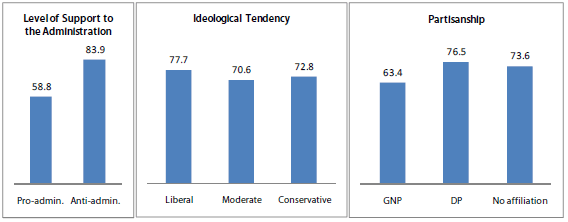
Poor Response Amplified the Feeling of Insecurity
The percentage of respondents who felt a sense of insecurity was 85.6% among those who criticized the government’s reaction. This number is 15% points higher than those who believe the government’s reaction was proper, which accounts for 71.6%. The negative perception of the government’s reaction amplified the citizens’ feeling of insecurity more than anything else. Regardless of whether the government’s reaction was effective or not, it is obvious that the artillery strike on South Korean territory and civilian infrastructure greatly increased the feeling of insecurity especially as this was the first use of artillery across the border since the Korean War.
Furthermore, this difference becomes magnified when the degree of insecurity is considered. Among those who support the government’s reaction, only 18.2% responded that they felt “very concerned” about the levels of insecurity. At the other end, 53.5% felt “slightly concerned” about the levels of insecurity. This shows that if the government’s reaction was considered to be appropriate, people would feel a low level of insecurity. However, among those who criticized the government’s reaction, as much as 41.3% felt “very concerned” about insecurity, while 44.3% felt “slightly concerned.” If the percentage of those that felt “very concerned” is compared, there was 33.1% difference.
Figure 5 Feeling of Insecurity in Groups with Different Assessment for the Government’s Response to the Attack
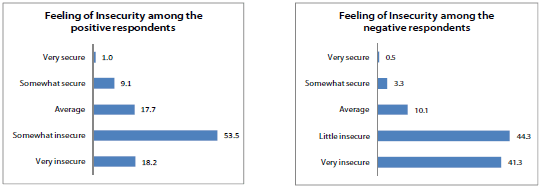
Detailed Evaluation of the Government’s Response: Merits and Demerits
Reflecting the strong criticism, the largest number of respondents (26.1%) answered that the government did nothing well. The second largest group of people (21.8%) stated that preventing the escalation of a wider conflict was correct. There was though a dispute on whether President Lee was within his capacity to give direct tactical orders on the initial response during the attack as the commander-in-chief. Support for maintaining a strengthened ROK-U.S. alliance (16.5%) came in next, followed by smaller numbers for a positive evaluation of the government’s military response (9.5%), managing citizens’ feeling of insecurity (9.4%) and economic risk management (6.4%).
Concerning what the government did wrong, the largest group of respondents, 36.5% of them pointed out the lack of a crisis management system. It is followed by 23.8% of the respondents who believed that the military response was too weak, 13.1% thought that confusion in the direction of the response to North Korea, and 11.4% who stated that confusion in the government’s official statement was wrong. Others answered that a lack of diplomatic influence towards Beijing (6.9%) was at fault while only 1.4% believed that there was nothing wrong.
The majority of respondents pointed out that the lack of a crisis management system and confusion in the government’s reaction rather than a weak military response was the problem. This indicates that not only changing the rules of engagement to modify the levels of response to military provocations, but also diagnosing the systemic problems in the government’s response are important. Specifically, confusion among different agencies and public statements during this crisis was a major concern for the public.
Figure 6: Detailed Evaluation of the Government’s Response to the Attack
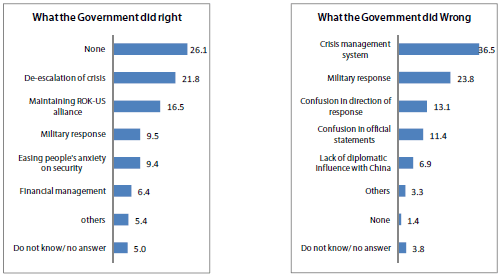
Progressives and Conservatives are Critical for Different Reasons
As mentioned before, not only the progressives but also conservatives did not perceive the government’s response to the attack on Yeonpyeong Island positively. Upon careful observation, however, they criticized the government for different reasons. According to Figure 7, 42.3% of the progressives and 41.5% of moderates answered that the lack of a system for dealing with a crisis was the government’s main failing. They are followed by confusion in the government’s official statements and confusion in how to respond to North Korea’s attack which both highlights the government’s inconsistency accounting for 23.9% and 25.0% respectively. 20.9% of progressives and 19.7% of moderates also indicated that a weak military response is a problem.
On the other hand, the largest numbers of conservatives (32.2%) pointed out the weak military response as a problem. It is followed by 27.8% of conservatives who concerned about the lack of a crisis management system. 25.7% identified the government’s inconsistency such as confusion in the government’s official statements and confusion in how to respond to North Korea’s attack as problems.
Criticisms prevail on the administration’s initial handling of the problem, for it focused on preventing escalation and managing domestic matters rather than countermeasures against the North. This acidic public opinion seems to mushroom with conservatives at the core. Amongst liberal and conservative voters, many denounced the administration’s lack of crisis managing system and political confusion. Though the administration’s positively-evaluated handlings are not being discussed at present—within the political community, the media, or the civil society—we would do better to pay more attention to them as well.
3. Changes in North Korea Policy Preferences: Comparing Public Opinion on the Cheonan Incident and the Attack on Yeonpyeong Island
Comparison of the Two Incidents
The biggest difference between the two incidents is that the Cheonan incident, in which a North Korean submarine infiltrated South Korean waters and sank a ROK Navy corvette in a torpedo attack, occurred within the guidelines of the “principle of distinction.” This prohibits any attack on civilians or civilian facilities, something that was not adhered to during the Yeonpyeong Island attack.
Figure 7: Different Reasons for Criticism by Ideological Background
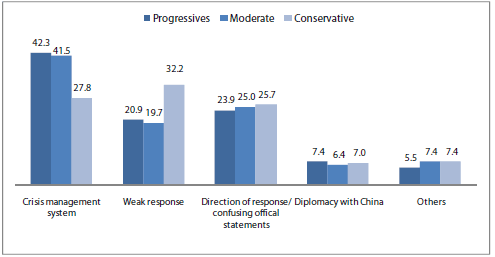
In the case of the Cheonan incident, it took two months for the South Korean government to officially confirm that North Korea was behind the sinking since Pyongyang denied any responsibility. On the other hand, Pyongyang officially admitted its involvement in the attack of Yeonpyeong Island only three days after the attack. Therefore, the two cases differ on responsibility and certainty of the cause.
The reactions of the neighboring states also show a clear contrast. For the Cheonan incident, there was divided international opinion on the cause of the sinking. The United States and Japan believed North Korea was responsible while China and Russia refused to state who or what was responsible for the incident.
For the Yeonpyeong Island attack, Moscow immediately stated that North Korea was responsible for their actions. Beijing at first focused on the fact that the incident took place right after the ROK military exercises, but they began to show a change in their position when the ROK-U.S. combined military exercises including the aircraft carrier USS George Washington took place in the Yellow Sea on November 28. Since the attack, Beijing has been trying to restrain North Korea from further provocations by trying to initiate talks with North Korean delegates.
The South Korean government’s response has also been different. Immediately following the sinking of the Cheonan, the Blue House stated that they were not certain that it was related to North Korea. In an effort to find the cause, the Cheonan was salvaged and an international joint investigation was launched. On May 20, 2010, the Joint Investigation Committee officially announced that it was a North Korean submarine that had sunk the Cheonan and on May 24, President Lee Myung-bak announced his measures for responding to future North Korean provocations during a televised address to the people. In these measures, Lee made it clear that Seoul will punish Pyongyang militarily, sever North-South relations, and refer the issue to the UN Security Council. Interestingly, this came before the June local elections which meant that 67.2% of respondents in a survey conducted on May 30 expressed doubt, believing that the ruling party was trying to use this incident for political purposes.
After the Yeonpyeong Island incident, doubts arose as the Blue House’s statements contradicted with the defense minister’s comments to the National Assembly. Some have argued that the ROK Marines’ counter-battery fire was ineffective and that the government had not prepared for any attack despite some signals, such as North Korea’s movement of artillery to the coastline. A few days after the attack, Defense Minister Kim Tae-Young resigned as he tried to placate the uproar.
Table 1 Summary of Cheonan / Yeonpyeong Incidents
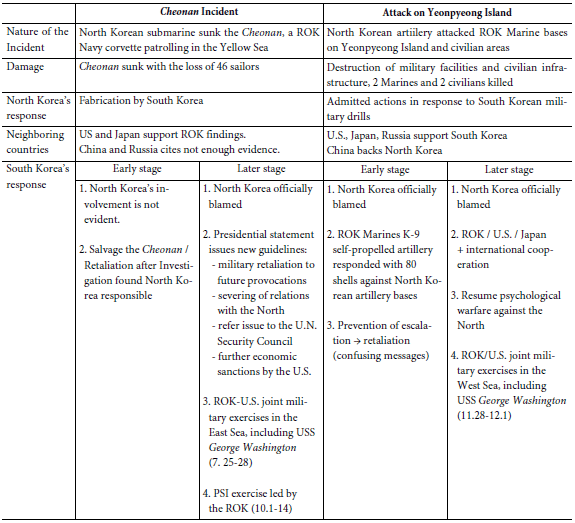
Comparison of Public Opinion on the Two Incidents
It is evident that the evaluation of the response to the attack on Yeonpyeong Island is far more negative than that of the Cheonan Incident. On April 24, 2010, before the official announcement by the South Korean government on the sinking of the Cheonan, less than half of the respondents (41.2%) believed that the administration’s reaction was good. However, on May 28, following President Lee’s televised address 57.6% of respondents had a positive view on how the administration was dealing with the crisis. Although it is too early to have a full picture, the current support rate for the administration’s handling of the Yeonpyeong Island attack is much lower (24.7%).
As Table 2 indicates, the evaluation of how the administration handled the Cheonan Incident is very much polarized. Progressives, Democratic Party supporters, and opponents of the current administration showed a negative attitude, while conservatives, GNP supporters, and supporters of the current administration expressed positive views. By contrast, the survey shows that not only the opponents of the administration but its supporters and conservatives have all expressed strong criticism toward the way the government has dealt with this latest incident, particularly in regard to its response.
Significant Changes in Opinion Regarding the Use of Retaliatory Measures
Until the Yeonpyeong incident, public opinion preferred the use of international cooperation or financial sanctions in times of crisis. People expressed mixed opinions on severing the relationship with the North, and most people disliked the idea of using force as a counter measure.
As Table 2 shows, policy options favored against North Korea following the Cheonan Incident were in support of approaching the UN Security Council (75.0%), with slightly tougher measures next, economic sanctions (58.5%) and severing relations (45.2%), while limited military retaliation (28.2%) figured less. After the attack on Yeonpyeong Island, however, 68.6% of respondents favored the option for limited military retaliation. This was the only dramatic change as the percentages on other categories did not alter significantly between the two incidents.
It is a clear sign that even moderates and liberals now believe that limited military action is needed in response to evident North Korean provocations. The fact that it was a direct attack on South Korean territory and that civilians were targeted seems to have had a significant impact.
Deepening of the “Ambivalent Attitude”: Accepting the military measures is going to be the turning point of the view on North Korea
The possibility for military action against the North has long been treated as a taboo in South Korea, but the recent incident seems to be a turning point. It would seem that a military response is now a priority as a final measure to deal with North Korea.
Yet, it does not look like the preference of the public has completely shifted over to harsh measures against the North. Table 2 shows that respondents who look favorably toward cutting off all relations with North Korea including tourism and economic activities stand at 42.5%, but those who oppose more hawkish measures outweigh them at 53.9%.
As shown in Figure 8, 42.7% of respondents said the Lee administration should “deal with North Korea harshly” while 55.2% said it should try to “engage and cooperate.” The number for hard line policies is up from 37.1% and the number for engagement policies is down from 61.5%. This is from June 5th, the last time the poll was taken. Despite this decrease, the majority of people still favor friendly and lenient policies.
Nevertheless, fear of total war is deeply rooted in the minds of the Korean people so that the growing percentage of respondents prefer a limited military response is only possible with the assumption that war is not going to occur. It can mainly be interpreted as the result of mixed emotional feelings at seeing the loss of civilians and damage of homes. This is a typical case of the “ambivalent attitude,” which is the coexistence of conflicting values, demanding a tougher response yet not willing to abandon engagement with North Korea.
ROK-U.S. Alliance, the Lever of Security for South Korea
During the Roh Moo-hyun administration, especially after the tragic deaths of two middle school girls by a U.S. armored vehicle in 2002, public opinion showed a tendency to improve the asymmetrical relationship between South Korea and the United States and transform the security policy dependent upon the ROK-U.S. alliance. Going through moments of crises such as North Korea’s nuclear and long-range missile tests, the Cheonan incident, and now the attack on Yeonpyeong Island, there has been a large increase in support for the ROK-U.S. alliance.
In January 2010, there was a political balance concerning the desirable relations between South Korea and United States (30.8% of respondents supported an independent foreign policy from the United States, 33.6% supported the status quo, while 34.7% supported strengthening the ROK-U.S. alliance). By July 2010, several months after the Cheonan incident, however, the percentage of respondents who supported an independent foreign policy had dropped to 23.7%. Supporters of the status quo dropped a little to 30.4%. But those who supported strengthening the ROK-U.S. alliance increased by 8.5% points to 43.2%.
After four months, this support has strengthened with the recent attack on Yeonpyeong Island. Supporters for an independent foreign policy have decreased further 12.7% points since January 2010 and now stand at 18.1%. Respondents who took the middle course and supported the status quo have not shown much difference, remaining steady at 30.5%. Those who believe that the ROK-U.S. alliance needs to be strengthened, however, have jumped to 48.6% which is an increase of 13.9% points. It can be seen that as inter-Korean relations become more strained and Seoul’s countermeasures towards North Korea are viewed as ineffective, public trust and expectation toward the ROK-U.S. alliance has strengthened.■
Figure 8: The Future Direction of ROK-U.S. Alliance and North Korea Policy
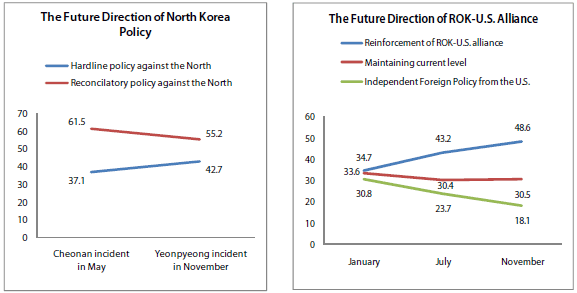
Table 2: Public Opinion Comparison between Cheonan and Yeonpyeong Incidents
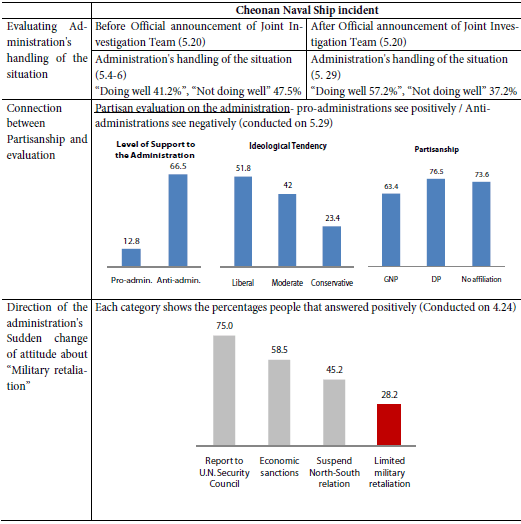
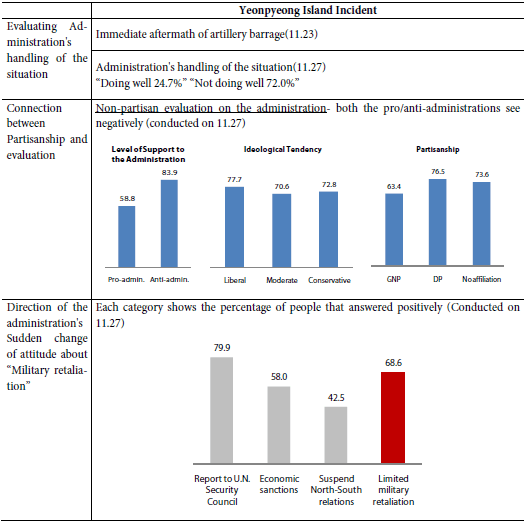
Center for North Korea Studies
Global NK Zoom & Connect
Global NK Zoom & Connect
![[ADRN Issue Briefing] Decoding India’s 2024 National Elections](/data/bbs/eng_issuebriefing/20240419123938102197065(1).jpg)
Commentary·Issue Briefing
[ADRN Issue Briefing] Decoding India’s 2024 National Elections
Niranjan Sahoo | 2010-12-02
![[ADRN Issue Briefing] Inside the Summit for Democracy: What’s Next?](/data/bbs/eng_issuebriefing/2024032815145548472837(1).jpg)
Commentary·Issue Briefing
[ADRN Issue Briefing] Inside the Summit for Democracy: What’s Next?
Ken Godfrey | 2010-12-02